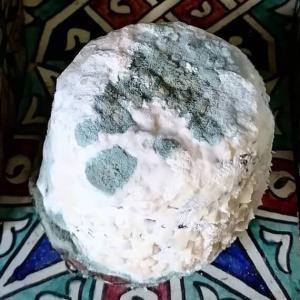If something is putting you off eating or drinking it, don’t eat or drink it. This has certainly become a rule I’ve grown to live by, ever since I started fermenting the hell out of everything. Interestingly enough my perception of aversion has changed considerably, just by experimenting and trying to control natural occurring processes of decay. It’s not that I’m more reckless or brash, but what used to be tolerable to me before often has become desirable now.
This has made me very aware just how much we are influenced by mass-food manufacturers, who have convinced us that that plastic-looking, bright-colored food with homogenous texture, vacuum-packed and provided with their trusted big-brand logos guarantees safety. Anything mouldy cannot but originate in unsanitary conditions. Right?
When I started creating our natural kefir based cheeses, I was obviously very concerned with sanitizing and sterilizing, being integral parts of the process. But my trust in the power of kefir’s microbes increased considerably along the way as I learned that, for example, the cultures on the skin of our hands (don’t worry, I do wash them regularly) can contribute microbes that are actually beneficial to the development of cheeses. Knowledge makes fear disappear, I guess. My natural preference for tools made out of wood for instance, seems illogical when it comes to sterilizing and cleaning. However, traditional cheesemakers originally used wooden tools all the time and this way unconsciously inoculated their cheeses with previous cultures.
I regularly created blue cheeses when I was still using a more conventional way, utilizing a Penicillium Roqueforti fungus I grew myself by spreading a piece of commercial blue cheese on sourdough bread and let it sit. Kefir however naturally gives priority to the growth of white fungi (it contains indigenous populations of Geotrichum Candidum) and although it is certainly possible I haven’t got around experimenting with purposefully creating blue kefir cheeses at Les Pierres.
Every now and then, one of the cheeses I do make turns blue anyway. I figure it has to do with the presence of moisture on the lid of the mason jars we use to age our cheeses in. I do forget to wipe them sometimes and when liquid drips on the cheese, I suspect this creates an environment more suited for these unsightly friends. Since it’s not a fungus I deliberately added, I must assume we’re dealing with Penicillium Commune that appears in the wild as a toxic blue fungus and is the most important spoilage organism in cheese.
So would we still eat it? The level of contamination by mycotoxins that this fungus produces is likely to be low and there is no direct evidence of human toxicity resulting from the consumption of cheese contaminated with mycotoxins. Nevertheless it is recommended that if cheese is visually contaminated, the contaminated portion of the cheese is to be removed to a depth of at least 2.5 centimeter. The diameter of our cheeses is 6 centimeter which leaves very little cutting space. Tant pis pour nous. You win some you lose some.
But wait. If a book is not to be judged on it’s cover, why should this cheese take a different fate? I’m not giving up that easy, am I?
Now that seems like a whole different story, doesn’t it? Because no, that’s not mould you see but chives.
So change of plans: it will not travel towards the garbage bin, but will find a nice spot next to the freshly backed sourdough bread on the dinner table tonight at Les Pierres. Because when something looks (and smells!) inviting to eat or drink, you should eat or drink it.
What would you do?
If Something Is Putting You Off
Trying to make ones life sustainable is more than a personal choice and almost automatically leads to a multitude of decisions you have never even thought of before. On this website we share what works for us, or woefully no longer works, obviously without claiming the same for you.
We hope that our journey towards a supplementary comprehensive celebration of nature’s beauty might just clear a pathway forward for you too, perhaps challenges a revealing reconsideration, or simply provides for an equally indispensable diversion.
Can we change the world through food? We believe we can and we support Slow Food, a global movement of local communities and activists across more than 160 countries. Together we defend cultural and biological diversity, promote food education and the transfer of traditional knowledge and skills.



Ahhh- now I get it! Ok. I think I always thought you were getting a free micro dose of prophylactic penicillin if you consumed that mold….
Thanks for the web link!
I love reading your insta entries!
Miss you and send tons of organic unpasteurized LOVE!!!
Thanks! Miss you too, you so belong into this magical French life we live. I guess I’m getting more and more tedious with the entries, cause Instagram and Facebook thought this one was too long. But hey, if it lures people to this space, that might be good too. I just feel I have a lot to talk about and am eager to learn from other people’s experiences too.